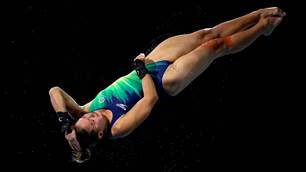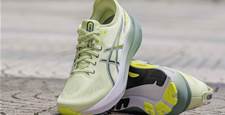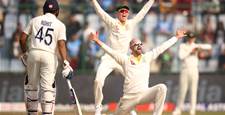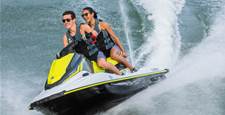Diving in Palau is like … Imagine seeing … It’s better than … It’s like nothing else you’ll see in your life.
Diving in Palau is like … Imagine seeing … It’s better than … It’s like nothing else you’ll see in your life.
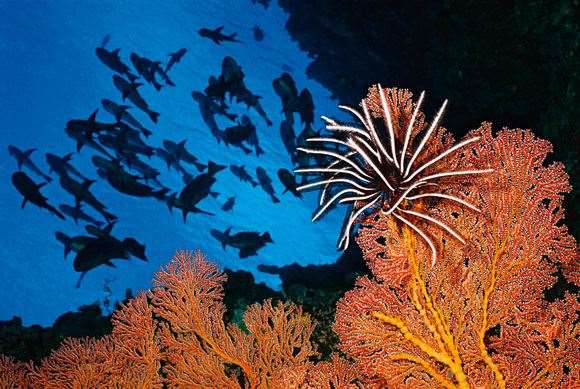 Surviving Palau is as easy as losing yourself in paradise
Surviving Palau is as easy as losing yourself in paradise
It’s difficult to describe diving in Palau. After all, everyone’s seen those National Geographic documentaries, where the walls of coral look like something from the drawing board of Gaudi and the fish resemble something from the palette of Dali; where the sun drenches everything in a golden haze and the lapping waves create hexagons of light and David Attenborough’s voice-over is so hypnotically modulated you feel yourself sliding into a transcendent daze ... So how exactly do I say the reefs of Palau are like that – but better?
I’ll give you an example. I’m hovering at a vast, buttressed cliff of coral called the Big Drop Off. I’m following a pack of purple fish, listening to their tiny jaws emitting a hum of static as they gobble at the coral, trying to avoid the filaments of turd they trail when they move to the next feeding spot. Suddenly, something below catches my eye. I bend forward and focus on it. It’s a huge fish hovering miraculously at my feet. It’s long and broad, with a crude snub-nosed face and a clean, tapering body. It’s coloured a coruscating yellow and bears two tapering black lines that run from its face down the length of its fuselage. And it’s hovering there, magically, quivering and waving in the current. I stare at it – no exaggeration – for perhaps 15 seconds before I realise that the words “Aqua Lung” are lettered in jaunty capitals right where the fish’s gills should be. For 15 seconds I’ve been staring at the flipper strapped to my left foot. Such is the disorientating wonder of the Palauan reefs.
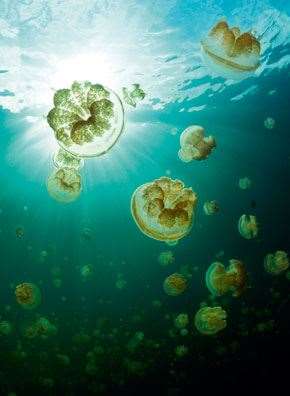 JellyFish Images: Pacific Flyer
JellyFish Images: Pacific FlyerFor those of you who don’t watch Survivor, Palau is a speck of a nation sitting in the westernmost corner of Micronesia, 800km east of the Philippines, 3200km south of Tokyo. In the past, reaching this place required 30-plus hours in a plane, island-hopping a dizzying network of South Pacific airports. Now the new PacificFlier airline runs a direct route from Brisbane. A day-and-a-half of travel has shrunk to six hours. The door is open.
Geographically, Palau concists of two basalt islands that promptly give way to a tight sprinkling of ragged limestone flecks that stretch to the south. To get a sense of these limestone islands it’s best to take a helicopter, to look down on them, each island as high as it is wide and impossibly jungled; tiny mountains jutting from the sea, carrying an impenetrable burst of vines and palms and creepers and great, spreading trees that tumble over one another, layer upon layer. The ocean works at these islands, nibbling away at the limestone, undercutting it, until great shards cleave away, leaving towering cliffs of bare, grey limestone amidst the splattered icing of jungle. Around these islands you can see the light patches of reef dropping abruptly into dark swathes of deepwater. And, if you’re lucky, you might just see a lone, grey dugong grinding through the water like an arthritic pensioner.
Back at water level, Jonathan – my dive instructor, a tiny Palauan with the unnerving ability to turn hypothermic when the temperature drops below 35 degrees – tells me there’s two reasons for the quality of these reefs. The first is that, on the islands of Babeldaob and Koror, the circling forests of mangroves haven’t been dredged and reclaimed and turned into beachfront resorts. As such, when it rains and the muddy water washes down from the ridges, it’s filtered by the mangroves. Mud is death to coral, Jonathan solemnly informs me. It clogs its pores and the animal slowly starves to death. The second reason is the currents that rush down either side of the islands. To the east of Palau is the Pacific, to the west the Philippine Sea, and both are rich in zooxanthellae, golden-brown protozoa that feeds the coral. “Zooxanthellae is life to corals,” he tells me. I ask him how to spell zooxanthellae. “Ah ... c ... o ... ” He shakes his head. “No idea.”
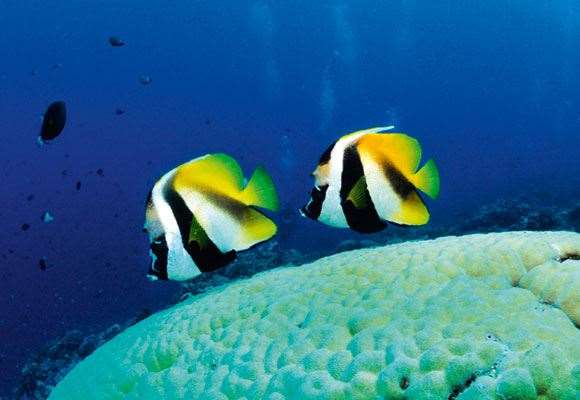 Fishes Images: Pacific Flyer
Fishes Images: Pacific FlyerIt’s a good thing the Palauan reefs are so well nourished because, as a novice diver, I find the task of examining them beneath a ten-metre ceiling of seawater acutely uncomfortable. I don’t like tight spaces at the best of times and I find the enclosing chamber of water unnervingly claustrophobic. It’s a state heightened by the desperate hollow rasp of my regulator and the unremitting pressure in my ears. I’m in a constant state of bewilderment. Time and again my lungs begin to ache and I realise I’m not sure whether I need to breathe in or out. My goggles fog over and my claustrophobia tightens. One moment I find the water unbearably cold, the next as warm as a bath. A mouthful of water makes its way through my lips and I have no idea how to get rid of it. I take my next breath through my nose and my mask sucks to my face with alarming ferocity. My breath becomes shallow as my heart rate rises. In all I’m doing exactly what Jonathan told me not to do. He glides alongside and gives me a questioning thumbs-up. I reply in kind, but I’m wondering if my ears will ever have the power of hearing again.
And then the reefs slide into focus and all is forgotten. At the walls that drop away into the deepwater, the coral is carved and chiselled, showing an epic cathedral austerity. I feel like a pilgrim at the Holy Sepulchre. At the saltwater lakes, ringed by sheer, jungled cliffs, reached by dark tunnels burrowed out of the limestone by the tidal erosion of the ocean, the coral shows a gentler market-garden quality; plated cabbage leaves and ripe tubers and gleaming, fruity bubblings. I have to resist the urge to snap pieces off and stuff them into my mouth.
 Kayaking in Palau
Kayaking in PalauImages: Pacific Flyer
Then there are the reefs that have grown around 60-year-old detritus from the battles fought here in WWII. The Japanese had occupied Palau since the First World War and by the time MacArthur’s marines hit the islands 30 years later they’d constructed a fasthold of pillboxes, trenches and tunnels. The Americans expected to take the Palauan island of Peleliu in a week. It eventually took three months and cost 10,000 casualties. These days the jungle has consumed the scars on the islands, but in the sea the wrecks have a ghostly, frozen quality. Jonathan takes me to an empty bay, hidden in the maze of limestone spires. It’s dark; the 50m cliffs of jungle turn the light a cold, green colour. On one side of the bay is an American Merlin, completely hidden beneath the smooth water. On the other side is a Japanese Zero, a single, bent propeller blade jutting from the water. Both are haired with brown moss. The spotted faces of fish peer from the fuselage pipes. Rub through the moss on the wings of the Zero and I can just make out the red paint of the rising sun. It’s studded with bullet holes.
There’s something ghoulish about these skeletons in the silent water. Even the fish look uneasy, skuttling about, cowering motionlessly in the hollows of the engines. After a while, I clamber back onto the boat, shame-faced, as
if I’ve been caught in a cemetery with a shovel. How long will it be before these wrecks are consumed by gleaming gardens of coral? As long as the mangroves remain and the currents flow, it shouldn’t be long.
Click on www.pacificflier.com for flights and www.fishnfins.com for dive information.
– Aaron Scott



